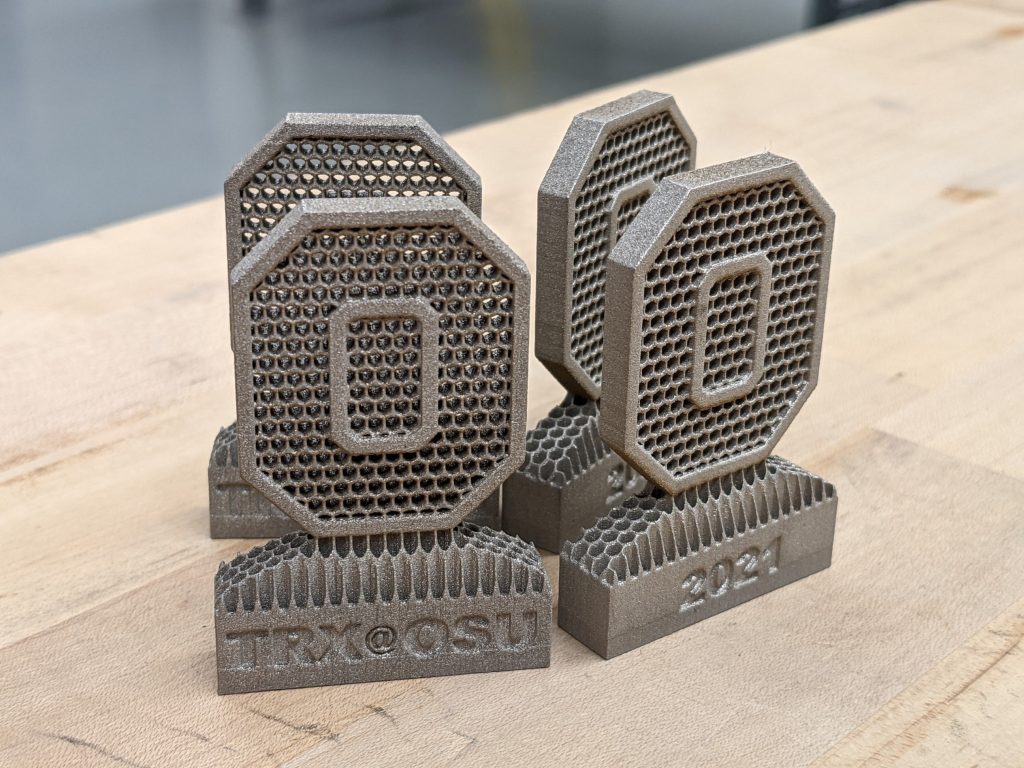Voting shortlists for the 2021 3D Printing Industry Awards are now open. Who do you think should receive top honors this year? Have your say now.
Ohio State University has partnered with French 3D printer manufacturer AddUp to bring industrial-scale production capabilities to student engineers at its Center for Design and Manufacturing Excellence (CDME).
As part of their collaboration, Ohio State’s CDME has installed AddUp’s high-throughput FormUp 350 system at its campus facility, where pupils, researchers and staff are working on ways of optimizing its performance. According to Ohio State itself, the installation could now enable its engineers to “deliver reproducible series of industrial parts,” and “further push 3D printing’s innovation boundaries.”
“The FormUp 350 has already equipped us with capabilities which we do not have with our other printers,” said Edward Herderick, Director of AM at CDME. “It has an open platform that allows us to tune strategies by accessing build parameters, and enables us to achieve enhanced material properties through processing fine powder. We now can take on more complex projects requiring larger parts.”
Modular LPBF with AddUp
Based in the French commune of Cébazat, but with a U.S. HQ in Cincinnati, less than two hours from Ohio State’s CDME, AddUp specializes in the manufacture of LPBF and DED systems capable of producing industrial parts at scale. At present, the firm manufactures components via its fleet of nearly forty machines, for clients in the aerospace, automotive and defense sectors, among others.
In order to improve its offering to such customers, the company has continually partnered with local research organizations over the last two years, first working with the Industrial Technical Center for Plastics and Composites to establish its ADDILYS tooling platform, then Oak Ridge National Laboratory to develop novel LPBF 3D printed metal molds.
More recently, AddUp has added to its existing portfolio of Modulo 250, Modulo 400, Magic 800 and FlexCare machines with its scalable new FormUp 350 system. Designed to tackle LPBF’s machine safety, productivity, quality, and obsolescence challenges, the new printer has four 500W lasers and a modular architecture, that enables users to consistently create industrial parts at higher levels of productivity.
Since being installed at the CDME last month, the machine’s 350 x 350 x 350mm build volume and unique powder rolling system, are already said to have allowed the center’s engineers to ramp up their throughput in an operator-friendly way.
“The FormUp 350 offers a modular build platform, which means we can quickly and economically scale from small research projects to full-scale industrial applications,” explains Ben DiMarco, an AM Technologist at the CDME. “The machine also offers an open interface that’s user-friendly. This feature is particularly valuable when training our student employees on the machine.”

An industry-ready approach
Based on Ohio State’s West Campus, the CDME works with local firms and researchers to translate advanced new technologies into market-ready products. Thus far, the center has completed more than 520 engineering projects alongside over 150 companies, providing its students with vital hands-on 3D printing experience, while helping the region’s businesses to compete in global markets.
Overall, the CDME houses some $13 million of industrial equipment, with $5 million of this relating to 3D printing. While this install base provides the facility’s team with metal, polymer, composite, biomaterial and ceramic-processing capabilities, its FormUp 350 installation could now allow its students to get hands-on with a more industrial machine, the likes of which they’ll encounter in their future careers.
Given that the CDME works with aerospace, automotive, medical and energy firms, its partnership with AddUp also provides the latter with the chance to showcase its new system to a wider customer base, while the fact that they’re both America Makes members, could create future opportunities for collaboration on rapid innovation projects as well.
“AddUp was familiar with Ohio State’s CDME and their robust AM program, so we were happy to partner with the facility to showcase the FormUp 350,” said Ken Wright, President of AddUp. “We are committed to innovation and leading the industry in PBF technology, so what better place to showcase that technology than in our own backyard at CDME.”
“We are excited to play a part in developing the future talent of the additive manufacturing industry.”

AM for the next generation
Given that universities are hotbeds for innovation, they’re often an ideal place for 3D printing firms to hone their technologies, while enabling students to experiment with them in return. Back in March 2021, for instance, Clemson University agreed an $11 million deal with DEVCOM ARL, to develop new ways of 3D printing parts for the U.S. military’s fleet of ground vehicles, air platforms and munitions.
At around the same time, the University of Graz announced that it was working with metallurgy specialist Heraeus Amloy, to create new alloys for 3D printing implants and prostheses. Due to amorphous metals’ unique mechanical properties, the devices are set to deliver enhanced performance compared to steel or titanium alternatives.
In the UK, as part of a similar project, the University of Birmingham has now entered into a collaboration with powder specialist Aluminium Materials Technologies (AMT). Together, the team’s engineers aim to investigate the properties of A20X aluminum when DED or LPBF printed, including how its composition changes and the impact of post-processing it.
To stay up to date with the latest 3D printing news, don’t forget to subscribe to the 3D Printing Industry newsletter or follow us on Twitter or liking our page on Facebook.
For a deeper dive into additive manufacturing, you can now subscribe to our Youtube channel, featuring discussion, debriefs, and shots of 3D printing in-action.
Are you looking for a job in the additive manufacturing industry? Visit 3D Printing Jobs for a selection of roles in the industry.
Featured image shows CDME engineers using their newly-installed AddUp 3D printer. Photo via AddUp.



